XENON

It is know from numerous astronomical and cosmological observations that the vast majority of the energy content of the Universe is dark: so far it is invisible to our detectors. About 70% is the mysterious dark energy, responsible for the accelerated expansion of the cosmos, and about 25% is made of dark matter. This yet unknown form of matter builds large scale structures in the Universe and dominates the dynamics of galaxies and galaxy clusters. Only 5% is made from ordinary matter such as protons, neutrons, and electrons which build atoms, molecules and eventually our "known" world.
We participate in the XENON dark matter project, which aims to directly detect the particle making up the dark matter and which should be present in our cosmic neighborhood in large amounts. Its interaction probability with normal matter, and hence with particle detectors, must be extremely weak, otherwise the dark matter would not be dark. However, there are plenty of models which predict that there should be a very small interaction probability. One promising candidate is the WIMP (weakly interacting massive particle), which arises naturally in many extensions of the standard model of particle physics.
LNGS: The Laboratory
The expected interaction rate in our detector is very low, but backgrounds are large since natural radioactivity is everywhere in the environment and cosmic rays also interact with detectors. Therefore, we need a detector with an ultra-low background. In order to achieve this, the XENON detectors are placed deep underground in the Italian Gran Sasso Laboratory (LNGS, in the Abbruzzian mountains) which reduces the rate of cosmic ray muons by six orders of magnitude.
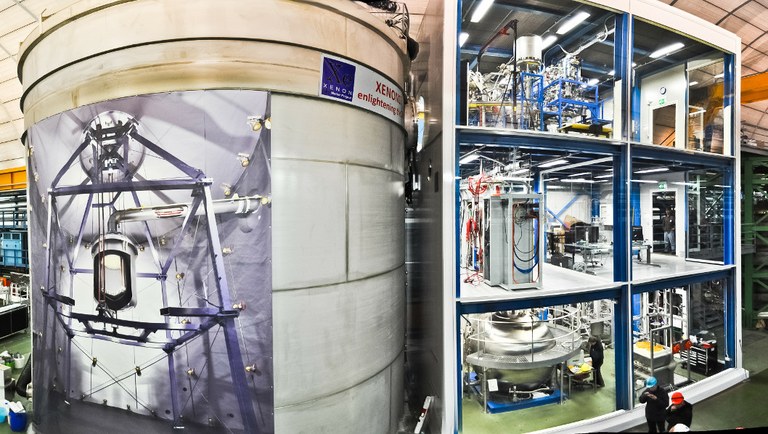
Fig: The XENON installations in Hall B of LNGS.
The detection principle
The XENON instruments are dual-phase time projection chambers (TPC) filled with ultra-pure xenon, which has been liquefied by cooling it to about -95°C. When a particle interacts with the xenon, it creates scintillation light and liberates electrons by ionization. Both signals, scintillation and ionization, are detected by a large number of photosensors. They are used to determine the energy deposition, the number of interactions in the detector, their 3-dimensional interaction vertex, and whether the particle looks more signal- or more background-like.
The combination of these features, together with a careful detector design and selection of all construction materials, allows achieving very low radioactive background levels - one of the prime advantages of this detector technology.
XENONnT: the current instrument
The XENON collaboration is commissioning XENONnT, the next phase of the XENON program. With a target volume of 5.9t and a 10x lower background compared to XENON1T, it is designed to explore dark matter interactions with an unprecendented sensitivity, down to the 10-48 cm² level (for spin-independent WIMP-nucleon interactions).
XENONnT will start taking data in early 2021. The following images show some impressions from the construction of the detector in spring 2020.
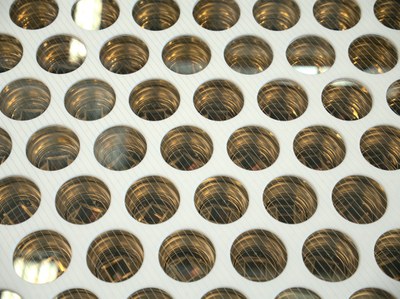 |
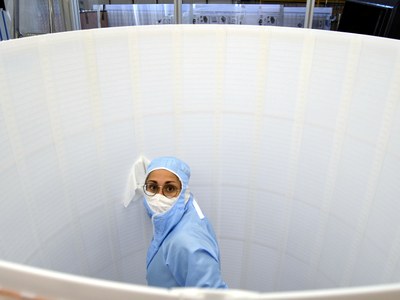 |
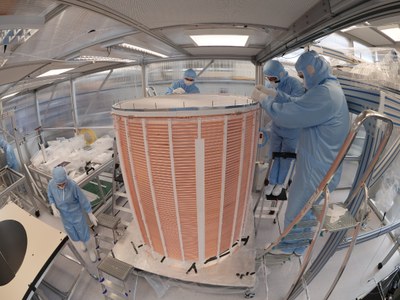 |
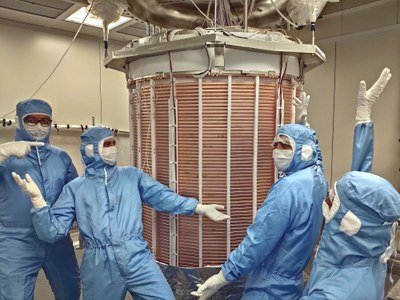 |
Figure: Construction of the XENONnT TPC. (top left) The Hamamatsu R11410-21 PMTs. (top right) Freiburg's Arianna cleaning the reflective TPC wall. (bottom left) Assembly of the TPC in the above ground cleanroom. (bottom right) Part of the Freiburg team during installation underground.
The responsibilities of the Freiburg group for XENONnT are:
- Data acquisition and electronics: We are responsible for the electronics and the data acquisition system for XENONnT. Our asynchronous trigger-less readout system with virtually no threshold from XENON1T will be re-used and combined with a very fast online processing tool.
XENONnT will also feature a dedicated high-energy readout channel to search for the neutrinoless double-beta decay of 136Xe. - Detector design: We are co-leading the design of the time projection chamber (TPC) of XENONnT with an emphasis on the elements ensuring the field homogeneity of the TPC field cage. We are also providing levelmeters for the TPC and low-background high voltage connectors and we are manufacturing many parts of the detector.
- Monte Carlo and backgrounds: We are involved in building the Monte Carlo model of XENONnT and used it extensively to check whether the cleanliness of materials is sufficient for the use in the actual experiment. We contribute to the material selection campaign with our low-background spectrometer GeMSE.
XENON is an international collaboration with more than 160 members from Germany, USA, Italy, Switzerland, France, the Netherlands, Sweden, Portugal, UAE, Israel, and Japan.
XENON1T: the past
The XENON collaboration has installed the dark matter detector XENON1T in November 2015. It acquired data until December 2018 and was decommissioned in early 2019 to make space for the successor project XENONnT (see below).
XENON1T was about 35x larger than its predecessor XENON100 (in terms of target mass) and used a total of 3.5t of liquid xenon. The larger mass, together with a very low background, allowed us to increase the sensitivity to dark matter interactions by a factor 100 compared to XENON100.
The first results from XENON1T were released in May 2017. A longer run, with a total exposure of 1 t x y was completed in 2018. No WIMP signal above the background expectation was observed, placing the most stringent limits on WIMP-nucleus cross sections to date (publication).
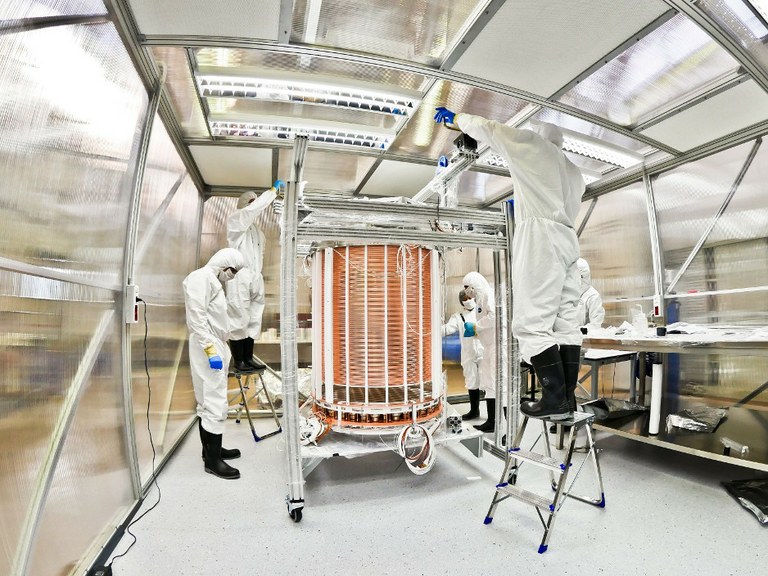
Fig: Assembly of the XENON1T inner detector (TPC).
The main responsibilities of the Freiburg group were:
- Data acquisition and electronics: We are responsible for the electronics and the data acquisition system for XENON1T. We have developed an asynchronous trigger-less readout system with virtually no threshold (publication).
- Detector design: We have led the design of the time projection chamber (TPC) of XENON1T. This is the innermost part of the detector which contains the active dark matter target. We are also involved in the development of low-radioactive detector components.
- Data analysis: XENON1T is the largest and most sensitive dark matter detector world-wide and we contribute to analyse its data.
Have a look at a short movie of the XENON1T construction: The XENON1T Story
Further Information
Official XENON website
Local XENON website
Dark Matter and Dual-phase Liquid Xenon Detectors
- Direct Detection of WIMP Dark Matter: Concepts and Status:
M. Schumann, J. Phys. G: Nucl. Part. Phys., arXiv:1903.03026 - Liquid Xenon Detectors: M. Schumann, JINST 9, C08004 (2014), arXiv:1405.7600.
XENONnT
- WIMP Sensitivity of the XENONnT Dark Matter Experiment
E. Aprile et al. (XENON), accepted by JCAP, arXiv:2007.08796
XENON1T
- Observation of Excess Electronic Recoil Events in XENON1T
E. Aprile et al. (XENON), arXiv:2006.09721 - XENON1T: Results from Science Run 1
E. Aprile et al. (XENON), Phys. Rev. Lett. 121, 111302 (2018), arXiv:1805.12562 - XENON1T Instrument Paper:
E. Aprile et al. (XENON), Eur. Phys. J. C 77, 881 (2017), arXiv:1708.07051
XENON100
- XENON100 Instrument Paper:
E. Aprile et al. (XENON100), Astropart. Phys. 35, 573 (2012), arXiv:1107.2155. - XENON100 WIMP result:
E. Aprile et al. (XENON100), Phys. Rev. Lett. 109, 131801 (2012), arXiv:1207.5988. - Annual Modulation Analysis:
E. Aprile et al. (XENON00), Phys. Rev. Lett. 115, 091302 (2015), arXiv:1507.07748.





